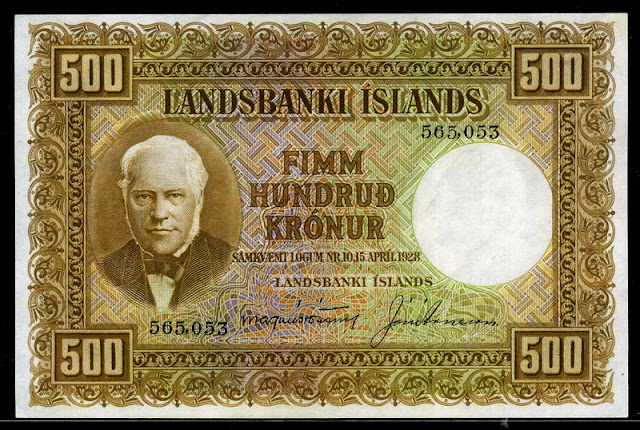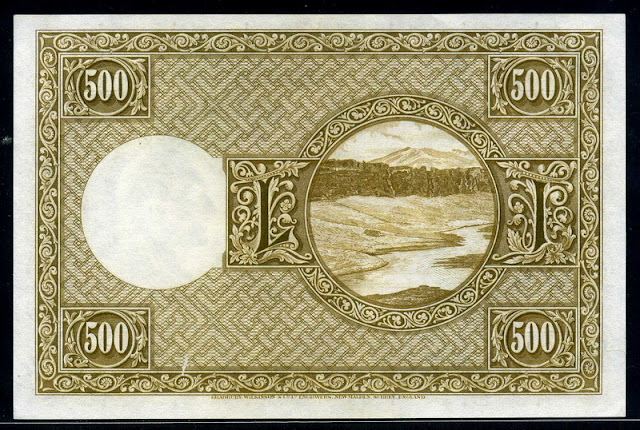Currency of Iceland 500 Kronur banknote 1928 Landsbanki Íslands (the national bank)
Obverse: Portrait of Jon Sigurdsson.
Reverse: View of Pingvellir National Park (Parliament Fields) near Reykjavik.
Iceland banknotes - Iceland paper money
L. 15.04.1928 First Issue
Jon Sigurdsson
Jón Sigurðsson (June 17, 1811 – December 7, 1879) was the leader of the 19th century Icelandic independence movement.
Born at Hrafnseyri, in Arnarfjörður in the Westfjords area of Iceland, he was the son of a pastor, Sigurður Jónsson. In 1833, he moved to Denmark to study grammar and history at the University of Copenhagen. Subsequently Jón began to work at the Arnamagnæan Institute, which was then the home of the manuscripts of the Icelandic sagas. He became an expert on the sagas and on Icelandic history. He never graduated from university, as Icelandic politics grew to consume all his time.
Before Jón moved to Denmark he proposed to his cousin, Ingibjörg Einarsdóttir, and she and her father, Jón's uncle, accepted the proposal. However Jón and Ingibjörg did not marry until 1845, when Jón came to Iceland for the first time since 1833 to sit at the restored Alþing. Jón had been elected to the Althing in 1844 as an MP for Ísafjörður county. He managed to hold on to this seat throughout his life although he did not attend all sessions of the Althing. In all, he came to 13 of the 17 sessions that were held in his lifetime. He also attended the National Assembly of 1851. There he led the Icelanders in their resistance to the adoption of Denmark's 1849 constitutional reform. The constitution was never formally adopted in Iceland, and after years of struggle the Danish Government granted Iceland a limited constitution in 1874 giving autonomy in internal affairs. Until then the Althing had only been an advisory body to the Danish government and king.
Jón's way of communicating with the Icelandic nation from Denmark where he lived and was to publish an annual magazine called Ný félagsrit (New Association Writings). It was published almost every year from 1841 to 1873 with Jón always being the main contributor and financial backer.
The home of Jón and Ingibjörg in Copenhagen became a centre for all Icelanders in the city. They had no children except for one foster-son who was Jón's nephew. However, a contemporary remarked that "all Icelanders are their children".
Jón was a classical liberal, unlike most of his contemporary and subsequent nationalists. Historian Gunnar Karlsson also describes him in the following fashion, "Jon Sigurdsson was by no means a typical 19th-century national hero. He was not an extreme nationalist and for his time, was rather devoid of romanticism. Above all, he was a protagonist of modernization, democracy, human rights and economic progress... Jon's career was not typical for a leader of a liberation movement either. He was never arrested for his political activity or spent a single night in prison. On the contrary, for most of his life he was sustained by rather generous research grants from various scholarly institutions, more or less funded by the Danish treasury."
He died in Copenhagen in 1879.
Legacy
His birthday, June 17, was chosen as Iceland's National Holiday to recognize his efforts toward Icelandic independence, and a picture of Jón graces the 500 Icelandic króna banknote.
He is often referred to as President ("Jón forseti") by Icelanders. The main reason for this is that since 1851 he served as President of the Copenhagen Department of Hið íslenska bókmenntafélag (the Icelandic Literature Society). He was also the president of Althing several times, for the first time in 1849. He is currently pictured on Iceland's 500 krónur bill, and has been honoured on Icelandic postage stamps on the centenaries of his birth and death, the 150th anniversary of his birth, and on the creation of the Republic of Iceland (on his 133rd birthday).
The apartment which Jón and Ingibjörg rented in Copenhagen from 1852 is called Jónshús and has been the property of the Icelandic government since 1967. It serves as a cultural center for Icelanders in Denmark, and as housing for academics on sabbatical.
Pingvellir National Park - Parliament Fields
Þingvellir, anglicised as Thingvellir, is a national park in the municipality of Bláskógabyggð in southwestern Iceland, about 40 km northeast of Reykjavík. Þingvellir is a site of historical, cultural, and geological importance and is one of the most popular tourist destinations in Iceland. It lies in a rift valley that marks the crest of the Mid-Atlantic Ridge and the boundary between the North American and Eurasian tectonic plates. To its south lies Þingvallavatn, the largest natural lake in Iceland.
The Althing, the national parliament of Iceland, was established at Þingvellir in 930, and held its sessions there until 1798. Þingvellir National Park (Icelandic: þjóðgarðurinn á Þingvöllum) was founded in 1930, marking the one-thousandth anniversary of the Althing. It was later expanded to protect natural phenomena in the surrounding area, and became a World Heritage Site in 2004.

